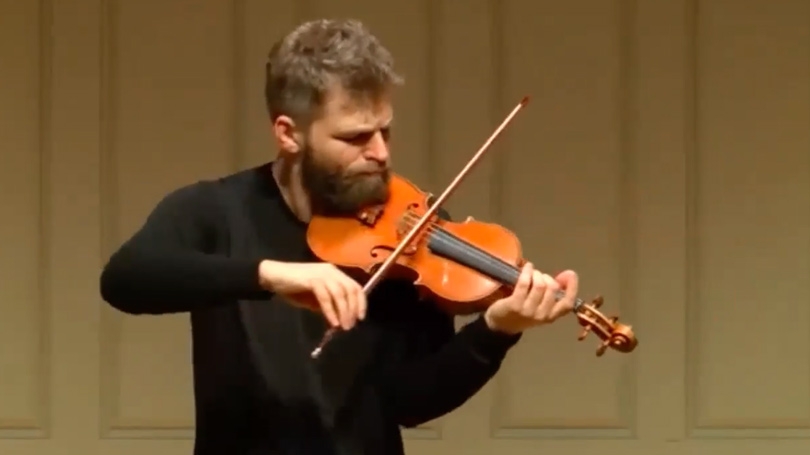Taking the Silkroad to new artistic futures: Lessons learned with Johnny Gandelsman and company
Moscow-born, Brooklyn-based violinist Johnny Gandelsman came to Professor Ted Levin's virtual class this October to talk with students about his musicality, the ins and outs of the commissioning process, and embracing the artistic restraints of COVID-19 – sharing the stage with composers Akshaya Avril Tucker and Kojiro Umesaki GR '93.
Johnny Gandelsman is many things: a virtuosic violinist, a Grammy-winning recording artist, and a record label entrepreneur. Coming later this season, he'll be something else, too: the debuter of a Hopkins Center-commissioned project featuring composer Kojiro "Ko" Umesaki. The work-in-progress, titled This is America, draws on the themes of multicultural musicalities and collaborations that Johnny has embraced in his professional career. In late October, Johnny hopped into Professor Ted Levin's "Global Sounds" course to talk about, well, just that: global sounds and the ways we make them. Early in the visit, he dropped this gem:
"As a musician who is rooted in classical music, my job is often to interpret compositions written by other people: Mozart, Beethoven, Brahms. But one of the great joys in my life is to work with composers who write music today. And commissioning is just that."
Now, that's all fine and well, but where does the process start? Does the composer strike up conversation with an instrumentalist, giving them a creative concept and limitations to work with? Or does the instrumentalist ask an admired composer to create a work for their instrument of choice, filling them in on their technical fortes, their no-can-dos, and their overarching aims with the project?
As it turns out, both and neither. Case in point: Gandelsman's two guests, Akshaya Avril Tucker and Kojiro, have each created a commission for Gandelsman, but followed very different paths. Gandelsman met Tucker at a workshop in California, and after hearing one of her works, approached her to inquire about commissioning a violin solo. She excitedly agreed, and Pallavi, a Meditation on Care (2019) was born thereafter. "I was so lucky. I just finished my masters at the University of Texas, and Johnny called me. It was great," she says. And as to who approaches who? "I think it can go both ways. It seems to be a little more common that [the instrumentalist is] coming to the composer, but the composer can also do a lot in terms of fostering those relationships" that become invaluable when seeking a commissioning project. "It's kind of an emerging network where everyone's creating ties with one another, sowing the seeds for projects that could happen in the future."
Ko is well-versed in these emergent networks of musicality. A 1993 graduate of Dartmouth's intimate M.A. program in Digital Musics, Ko has worked closely with Ted and Johnny as part of Silkroad, an ensemble and organization founded by Yo-Yo Ma to foster multicultural artistic experiences. It was a confluence of many great artistries: Johnny on violin, Ko on shakuhachi, and Ted as the organization's first executive director. Between the many different artistic mediums — shakuhachi, pipa, Bharatanatyam dance, and Galician Bagpipes, to name a select few — the creative possibilities in such a group can be limitless, if not a bit daunting.
But that's not a misstep on Ma's part; rather, it's evidence that a multicultural, multinational, multidisciplinary performing ensemble is possible. The students of "Global Sounds" and I saw this first-hand: we witnessed live performances of violin, shakuhachi, and Odissi dance all in one class, but it never felt disjointed or too wide-reaching. Rather, it highlighted how radically divergent artistic traditions can still be more similar than they are different. Before Akshaya performed Odissi for us, she had us tune into our bodily state. After many students chose the adjective of "sleepy" as their descriptor, Akshaya performed a Odissi expression for 'repose': a flowing choreography that transcended the constraints of time signature, ending with Akshaya fashioning a pillow with her hands and resting her head tranquilly. This improvisational departure from a regular beat was something that Kojiro embraced, too. Prefaced with another grounding exercise (this one focused on breath), Ko performed a shakuhachi piece from the Fuke-shū tradition. Like Ko's own compositions, the piece didn't have a clear rhythm. Instead, Ko encouraged us to treat each of its phrases like a breath, inhaling when the instrument began its first tone, and exhaling after it concluded the second.
Even as a Music major, this was something I had never witnessed in a live setting. Time signatures and measures constitute my safe space, and trying to envision performing seven minutes of music without either makes my brain implode. But here it was in the flesh: Akshaya and Ko, two successful composers and multidisciplinary artists who disregarded Western timing in favor of other notational alternatives. Johnny also had the chance to flex his musically subversive chops: he performed a snippet of "This is America" – which Ko timed exclusively in breaths, not beats – to great excitement and acclaim on behalf of the class. If I learned anything from Johnny, Ko, and Akshaya during their visit, it was that even the most steadfast rules of Western music are allowed to be broken. It just helps having a group of like-minded composers, innovative collaborators, and musical friends who will break them with you.
